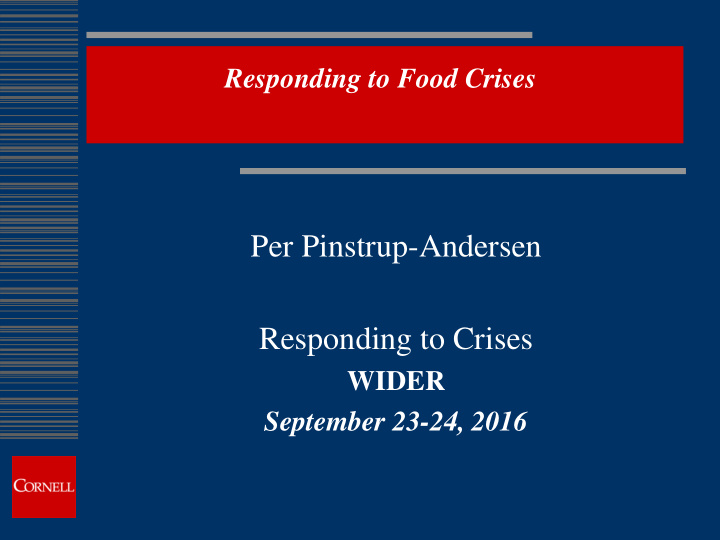



Responding to Food Crises Per Pinstrup-Andersen Responding to Crises WIDER September 23-24, 2016
My two main messages 1. We should agree on what we mean by “food crisis” 2. A political economy analytical approach is needed to better predict and recommend responses by relevant stakeholder groups.
Perceived meaning of the term “food crisis” Which indicators? Large drop in food production or supply Large increase in food prices Large increase in prevalence of food insecurity, malnutrition or health Global, national, community, or households? Inter-market transmission and interaction
Causes of food crises Income fluctuations Climatic fluctuations Armed conflicts Speculation and market manipulation Political factors
Who are the “Instigators” and “Responders” (1) Government agencies Civil Society Private sector Farmers Agribusiness (post-harvest supply chain) Consumers International agencies
Who are the “Instigators” “Responders”? (2) Food Policy Analysts and advisors Agricultural research organizations Foreign direct investors News Media
Response motivations Legitimacy goals Governments Private sector (Social responsibility) Revenue (profit) goals Humanitarian goals Protection of food security, nutrition, health. Avoiding deteriorating poverty
A political economy analysis of Global food price volatility Selected empirical findings from a collaborative study WIDER – Cornell – Copenhagen University
14 Participating Countries (Bangladesh, Brazil, China, Egypt, Ethiopia, India, Kenya, Malawi, Mozambique, Nigeria, Senegal, South Africa, Vietnam, Zambia) European Union United States Map Source: www.presentationmagazine.com Collaborating Institutions: Cornell University, Bill & Melinda Gates Foundation UNU-WIDER, and University of Copenhagen
Were Food Price Fluctuations in the World Market Transmitted to National Markets?
Wheat Prices in the World Market, South Africa and Bangladesh, 2005-2012 Source: Baltzer (2013)
Rice Prices in the World Market, China and India, 2005-2012 Source: Baltzer (2013)
Maize Prices in the World Market, Malawi and Zambia, 2005-2012 Source: Baltzer (2013)
Policy Responses: Two Options Pursued 1. Decouple world market and domestic prices 2. Permit price transmission and compensate losers
Political Economy Lessons (1) 1. Protecting government legitimacy 2. Pursuing domestic policies irrespective of international consequences 3. Unitary government decision-making is unusual 4. Repeating past or expanding current policies (path dependence) 5. Relative power of stakeholder group varied
Political Economy Lessons (2) 6. Increasing urban bias 7. Smallholders versus larger farms 8. Mutual mistrust between government and the private sector 9. Foreign agencies had little influence
Recommendations Protect price signals Emphasize targeted compensation over price interventions Risk management tools for all system agents Seek high levels of price transmission Seek low levels of trade restrictions
Recommendations (2) Increase supply elasticities for food Improve management of cereal stocks Seek competitive behavior in supply chain Make demand for biofuel input price-related Strengthen international agreements regarding exporter behavior Improve public-private collaboration
Sources Per Pinstrup-Andersen (Editor). Food Price Policy in an era of Market Instability. Oxford University Press, 2015. www.wider.unu.edu/foodpricepolicy
Recommend
More recommend